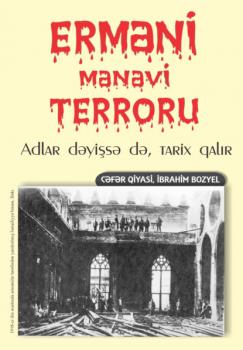JekaPrint
Все книги издательства JekaPrintArmenian Acts of Cultural Terrorism
A careful exploration of the lands and place-names is necessary in order to understand the history, culture and language of a dynasty. When tracing back the roots of a nation, history of the language and all the proper names play a particularly important role. Names of every surface feature -stream, lake, mountain, regions- bring to light a millennium of the nation's history. In short, proper names comprise the book of a nation's past and future. The more you read the book, the more you can find out sound information about the present and the past. Hydronims, oronims, etnonims and urbanonims that reflect the very identity of peoples are created and preserved in their mother tongue. Historical sources make it evident that districts, such as, Göyce, Zengezur, Vedi, Erivan, and so on, have been the ancestral and eternal lands of Azerbaijan. A thorough examination of the geographical names of these lands will reveal once again that they are the habitat of the Turks. Turkish place-names of West Azerbaijan, today's Armenia, have not yet been investigated. It is a historical fact that until the beginning of the 19th century, most of the place-names in Armenia were of Turkish origin. In his Population of Soviet Armenia, published in 1932, Z. Korkodyan reports that in the 19th and early 20th centuries, about 2000 cites of the total 2310 were of Turkish origin. After the annexation of Azerbaijan by Russia following 1828 Turkmencay Agreement, some of the Armeni-ans emigrated from Turkey and Iran were allocated in the Turkish villages in West Azerbaijan under provocations by the Russian Empire. At approximately the same time, Azerbaijani Turks were expelled from their ancestral lands. Their historical monuments were destroyed, and place-names were changed. The existing Armenian name changing policy was added a new parameter af-ter the revolution. Names of hundreds of villages were changed into artificially pro-duced Armenian ones by official decrees. This officially approved operation of name changing was enacted in 1935, and the Azerbaijani Turks were expelled from their lands. Villages were partially banned from being resided and they were ruined. These evacuated villages used to be the sites having marks of deep-rooted Turkish history. They display important solid evidence suggesting the evil aspirations of the Armenians. Here are some examples: In the region of Zengibasar: Hesen Ağa, Qaracalar, Ozanlar, Tercan and so forth, In the region of Vedibasar: Saray, Şorsu, Hesen Qala, Günlük, Qızılveren, Qazançı and so forth, In the region of Goyce: Buğdatepe, Üçtepe, Ağrıca, Allahverdi Bey, Ağsaq Tauz and so forth, In the region of Dereleyez: Kelyataçı, Boyadere, Boğacık, Qulu Baği and so forth, have been the victims of cultural genocide. … ...
Erməni mənəvi terroru
Azərbaycan davası böyük və müqəddəs davadır. Tez və ya gec – haqlı olduğumuzu, qürur və ləyaqətimizi bütün dünyaya sübut edəcəyik. Ancaq bu müqəddəs savaşı anlamaq, başqalarına anlatmaq və bu yolda usanmadan çalışmaq gərəkdir. Əlinizdəki kitab bu yöndə sizə əvəzsiz xidmət göstərəcək… Kitaba erməni qəsbkarlarının müxtəlif dövrlərdə dəyişdirdikləri 600-dək türk yer adlarının siyahısı əlavə olunub.

